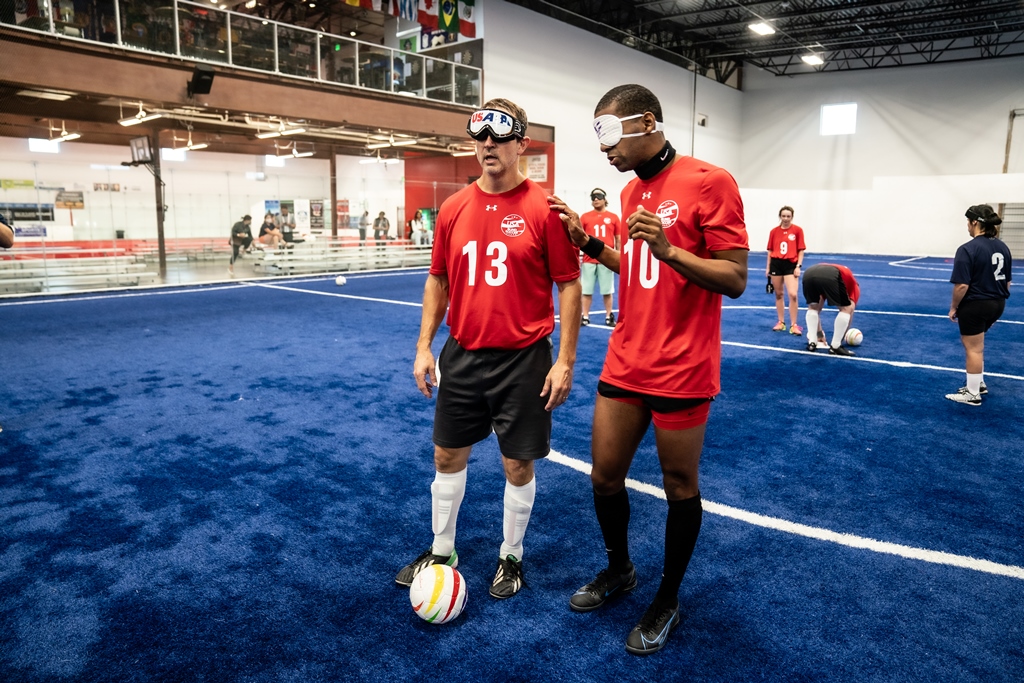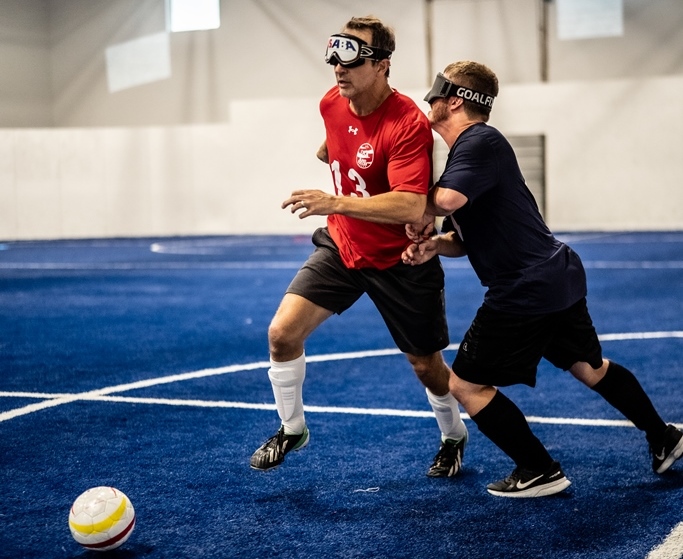USABA Building Blind Soccer Ahead of LA28
By Michael Lewis, TeamUSA.org

Jaime Garzon has dreams, some of them big ones.
Not only does he want the United States to field a men’s blind soccer team for the 2028 Paralympic Games in Los Angeles, he also wants it to compete for a medal.
There’s one slight catch — the U.S. does not have a blind soccer team, at least not yet.
But with the United States earning an automatic berth as host of the 2028 Summer Games, the clock is ticking. The United States Association of Blind Athletes and Garzon, the organization’s soccer manager, are leading the charge to create a team, which means developing the sport at both the local and national level over the next seven years.
“We don’t want to just participate. We want to get there and make sure that we’re going to try to do our best to get a medal,” Garzon told TeamUSA.org ahead of National Blind Sports Day on Saturday. “Our main goal is to showcase to this country that this sport exists. That is an opportunity for people with visual impairments to play soccer.”
Blind soccer is a 5-a-side game for visually impaired athletes. As in goalball, another Paralympic sport for visually impaired athletes, the ball has a bell inside, giving players an audible reference for where it is. Only the team’s goalie can be sighted.
The sport has been included in the Paralympic Games since 2004 in Athens, but Team USA has never fielded a team.
Garzon is bullish on creating a competitive U.S. men’s side.
“I’m very optimistic that the game will grow,” he said. “I’m very optimistic players will fall in love with it. It all depends on the players. As administrators and coaches, we can set up a foundation. Our players are the ones that win the games.”
Creating the infrastructure is the biggest challenge, Garzon said.
“How do we create those opportunities across the different states?” he asked. “If we have a state where they don’t have a school for the blind, how do we how do we reach out to them? How do we show them that it’s possible and then how do we create a path for them to at least try out for Team USA?”
Building a team starts at the grassroots level.

As part of National Blind Sports Week, the USABA held a blind soccer clinic Thursday at the Colorado School for the Deaf and Blind that showcased the sport to students.
“Hopefully, they can put this programming in the curriculum for the future,” Garzon said.
The USABA plans to host clinics and camps to educate coaches and players. Schools will be able to create teams that compete in leagues or tournaments. From those competitions, the best players will form a national team.
Teaching the teachers — i.e. the coaches — is vital.
“The key part with player development is to find the players, but the more important piece is to teach someone how to teach the game,” Garzon said. “If we have a player in Iowa that comes out to a regular club and says, ‘I want to play soccer,’ we have permission there for someone to start teaching the game. Once we start that all over the country, we can start creating clubs in the cities. Once you have clubs then you can move to regional events, national events and so on.
“We are lucky enough that soccer is a well-recognized sport across the U.S., that is well positioned at the club level. We just want to be part of that movement to see how we can use utilize that path for us to bring players to our sport.”
That will mean working with local schools and local and regional soccer associations.
“We want to start working partnerships with U.S Soccer, U.S. Youth Soccer, where we can use their paths that they already have in place across the country, with clubs, with the state associations, as well as the schools for the blind,” Garzon said.
Garzon would like to see local clubs being created next year and add regional tournaments by 2023.
However, even that could be sped up.
Dr. Skye Arthur-Banning, a blind soccer referee and an associate professor at Clemson University, said if the U.S. wants to qualify for the Paralympics, it would have to go through the likes of traditional powers Brazil and Argentina, as well as 2016 Paralympic debutant Mexico. That won’t be an issue for 2028.
“That’s just so exciting to be able to tell athletes that if you make this team and compete through that cycle, you will play in the Paralympic Games,” he said during a blind soccer panel discussion Thursday. “That is something that just doesn’t come along very often. We don’t want to have a team ready for 2028. We need to have a team right probably for 2024 (when the Paralympic Games are in Paris) so that we can compete in that four-year cycle leading up to 2028.”
Blind soccer is played on a 20×40-meter field with sideboards. Games are divided into two 20-minute halves.
While the game resembles traditional 11-a-side soccer, certain rules facilitate the gameplay for the visually impaired athletes. In addition to the bell inside the ball, defenders must yell “voy” — Spanish for “I go” — when approaching. Spectators must stay silent, so players won’t be distracted and miss the sound of the ball.
Many countries have gotten a head start, having played internationally for decades. Brazil maintained its stranglehold on the Paralympic gold medal this summer when it defeated Argentina 1-0 in the final in Tokyo. The gold was Brazil’s fifth in the sport’s five Paralympic tournaments, while Argentina has now medaled in four Games. Spain, which has been playing blind soccer since the 1920s, is the only other country to qualify for all five Paralympic tournaments and twice won a bronze medal.
To reach that level, the learning curve will be great.
“For men, we are towards the bottom, to be honest,” said panel member Timothy Taylor, coach of the Maryland School for the Blind soccer team. “I think we could put a team together. We could handle some other countries. We’re novice. We’re new. We’re learning. We’re at the youth level almost and working our way up, which is fine.”
Added Garzon: “These countries at the elite level have been playing for 30 years. We have a gap to hopefully to reach. How fast we reach that gap, it will depend on how fast we start on the element of the game in the country. The U.S. has an extensive population, and the game is well known. We’ve got to create opportunities for the players to come out.”
Women’s blind soccer is not part of the Paralympics and won’t be in 2028, but it could be added to the 2032 Paralympics in Brisbane, Australia, Garzon said.
“We’re in a time where the women’s game is exploding globally,” he said. “You have leagues almost in all the countries in Europe and South America. In blind soccer, this movement is just starting as well. We’re in a position where we’re going to develop both the male and the female teams at the same time. Hopefully that gap on the girls’ side won’t be taking as long as the guys could take.”
That would be fine with 19-year-old Bailey Martin of Hubbard, Iowa, a track and field standout who has picked up the game.
“My short-term goal is getting on a team, getting better and working on different skills,” she said during the panel. “My long-term goal is winning more than one Paralympic gold medal for soccer.”
As it turns out, Garzon and Martin weren’t the only ones with big dreams.
So does coach Taylor.
“I want to be on that 2028 team in Los Angeles,” he said. “That is a goal I set for myself — to be either on the sidelines or be a part of that organization that sends that team to the Paralympics in 2028.”
Prior to that, there will be much work to do.
Michael Lewis
Michael Lewis, who covers soccer for Newsday, has written about the sport for four decades and has written six books about soccer. He is a freelance contributor to TeamUSA.org on behalf of Red Line Editorial, Inc.
Related Posts
USA Blind Soccer to Host Romania for International Matches in Colorado Springs April 26-27Team USA Men’s and Women’s Goalball National Team’s Set to Compete at Berlin Nations Cup
U.S. Association of Blind Athletes Announces Newly Appointed 2025 Board Members
2025 Sport Ambassador Applications Now Open
2025 USABA National Goalball Qualifying Tournaments
